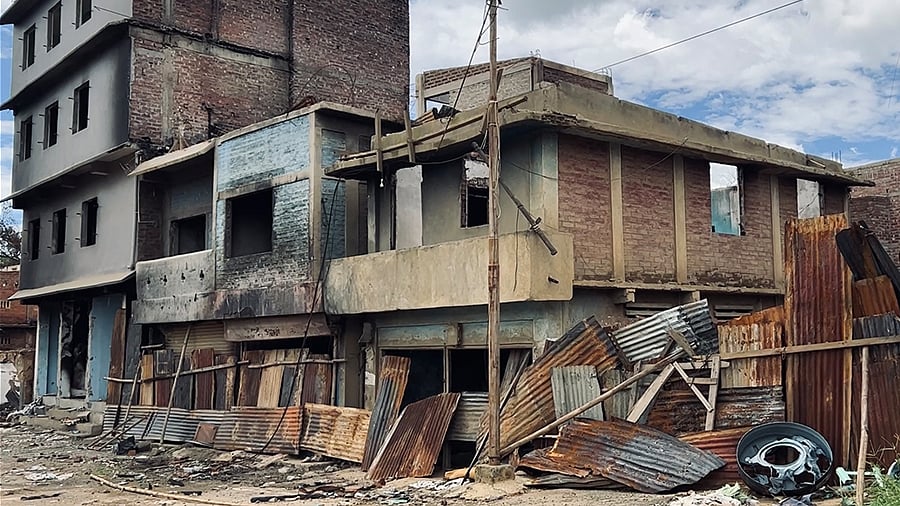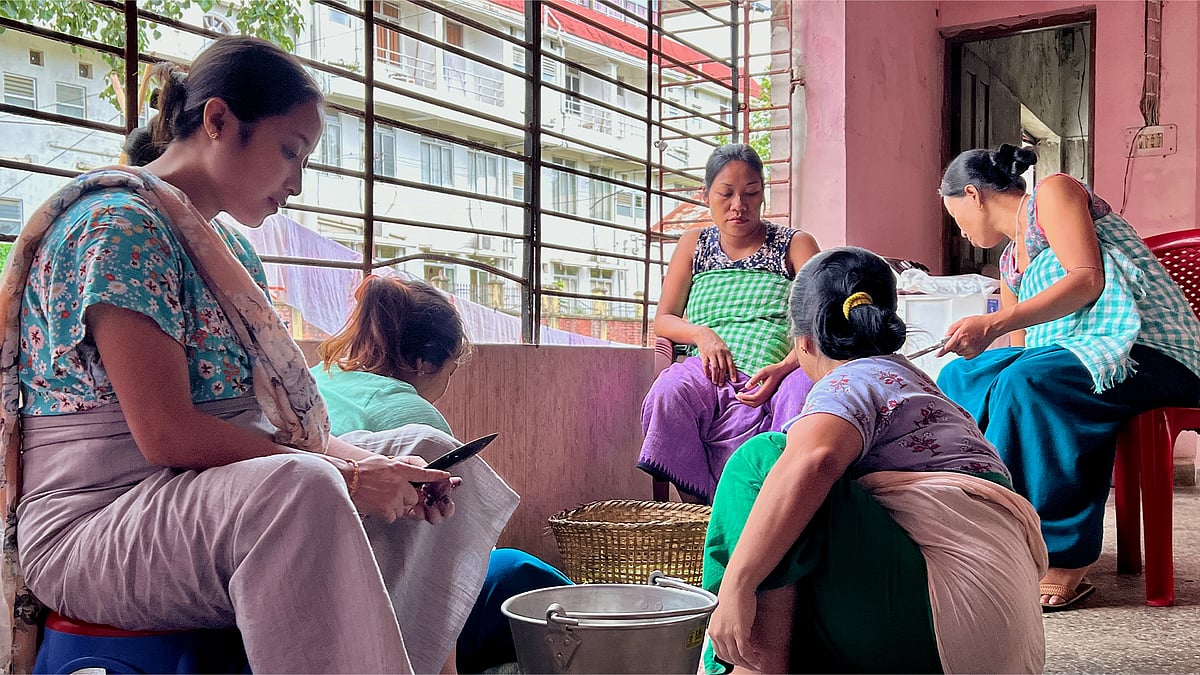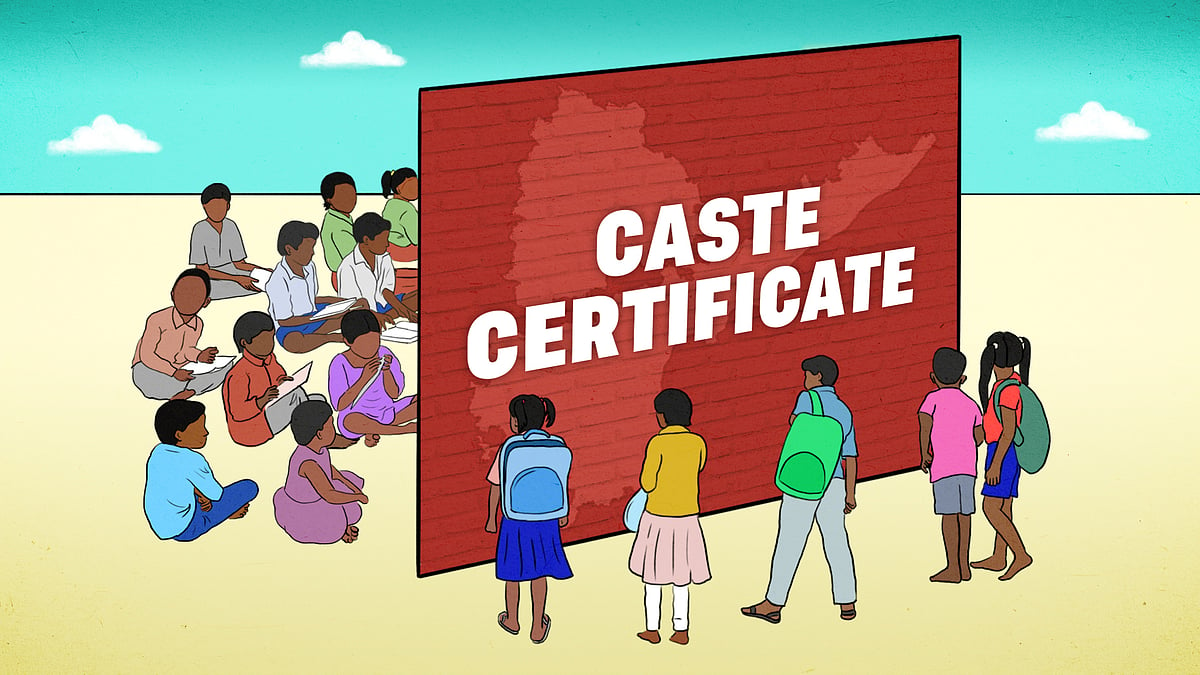‘Wanted to become a scientist before he died’: Kuki children of conflict look to ‘reverse time’
The conflict has displaced over 14,000 schoolchildren so far. Will Modi mention it in Parliament today?
In Churachandpur’s Tuibuong, Kuki children staying in the Grace Academy relief camp line up with copies of the Bible to attend Sunday mass. Once a school for Tuibong’s Meitei and Kuki children, the building now serves as a makeshift relief camp for displaced Kuki families from Kangpokpi – sheltering 124 people, including 70 aged under 18 years.
Thirteen-year-old Ginminthang, however, sits in a corner, away from his new friends. Once a chirpy teen, Ginminthang has changed since he saw a photograph of his grandmother’s body, his mother Nem Kho Chong tells Newslaundry. “His pi (grandmother) was shot four times in a church in Khoken, Kangpokpi, while she was praying. Her arms were then mutilated by a mob.”
After clashes in Churachandpur on May 3, Ginminthang fled his home in the adjoining Kangpokpi district with his father and two siblings, while his mother and his 75-year-old grandmother Dom Kho Hoi stayed at their Khoken residence. “She was killed on June 9 after a mob entered our village at dawn,” says Nem Kho Chong.

“I cried when my siblings showed me the photograph. We were very close,” Ginminthang feebly says. “She told me how to behave, gave me guidance on how to live life correctly. She was very wise.” Asked what he misses the most about his house, Giniminthang says, “my grandmother”.
According to the Ministry of Education, the three-month long conflict has led to over 14,000 schoolchildren being displaced in Manipur. The issue is set to come up in Parliament again on Thursday with Prime Minister Narendra Modi expected to address the House amid the opposition-sponsored no-confidence motion. On Wednesday, Congress leader Rahul Gandhi hit out at the prime minister for not visiting Manipur even once since the violence began in May.
‘I will become an officer to fulfil his wish’
Ginminthang is not the only one at the camp to have lost a family member to an attack by a mob of 40 men, who opened fire at locals in Khoken at 4 am.
“We were hiding in the jungle when my father was ambushed by a mob on the main road,” a frail Lam Kho Hen says. The 12-year-old lost his father, Jang Pao Touthang, in the same attack. The family left their house on May 3 and moved to a secluded hut in the jungle close to Khoken, but Lam’s father stayed back to guard their village.
“He spoke to me on the phone minutes before he was killed. He was coming to us, so I told him to take a shortcut and not come via the main road. He said there’s nothing to worry about,” Lam’s mother Lhing Neng Touthang says.
“I wanted to become a scientist before he died. But I will now fulfil his wish and become an (IAS) officer,” Lam says. He tears up while recalling the time he spent with his father on their pineapple farm. “They took him from me.”
“Before he died, I was a child with innocence, but now I feel weight on my shoulders,” says Kim Vah, Lam’s 18-year-old sister who now wishes to become an IPS officer “to protect her people.” “When we heard gunshots at 4 am, I prayed for his life. His last words to us were ‘everything is fine’.”


About 2,800 children have been displaced in Kangpokpi, while over 4,000 have been displaced in Churachandpur – the centre of the conflict. Thirteen-year-old Pao Min Sang, who studied at Khoken’s Excel Academy, now feels that he will never be able to go to school again. “My father was shot protecting our village. I don’t think we’ll ever have the money for me to go to school again,” he says. The eldest child in his family, Pao “is not strong anymore,” says his mother Neng Tin Lhing Guite. “His heart is weak now.”
Neng Tin had moved to the Grace Academy relief camp on May 13. Like Lam’s father, Pao’s father Khaimang Guite too stayed back to guard their home. “I have been terrified ever since I saw the picture of his body. But I think he wants me to stay strong, take care of my mother,” Pao says.
Having moved to a small rented accommodation nearby, Neng Tin says that she will try her best to raise Pao on her own, since her husband “tried his best to protect them”.

Meanwhile, at the St Mary’s relief camp a few kilometres away, 11-year-old Mangmimkap recalls the night he saw the Serou village in Kakching district burn from the top of a hill. Once dominated by Meiteis, Serou was attacked on May 27 by an armed mob, leading to a retaliatory attack on the Kuki homes in the adjoining Sugnoo a day later. “We fled from our home when we heard gunshots in Sugnoo. As we walked towards the neighbouring village to seek protection, I saw several homes lit on fire,” he adds.
Mangmimkap is one of the 47 children from Chandel district who have been staying at St Mary’s since the makeshift relief camp started on June 3. Most of the 147 inhabitants here belong to Sugnoo – an area which has turned into a ghost town since the attack.



“My home was burnt by a mob, but I don’t miss it that much. However, I miss playing football with my friends,” Mangmimkap says. On being asked if the gunshots scared him, the 11-year-old says, “No, I am not scared of guns anymore.”
His fellow resident Celena Lamneitham, however, adds that she misses the Jesus portraits that hung in her room. The 16-year-old looked forward to strolling through Sugnoo bazaar every evening with her friends and going to her parish every Sunday, but is now forced to spend her days inside the relief camp. On seeing Newslaundry’s photographs of what now remains of her town, she identifies her parish and tears up.
“I want to reverse time and warn everyone of what was coming,” Celena says, adding that she also misses some of her Meitei friends. “It wasn’t their fault.”


Meanwhile, 12-year-old Ngamminsang, who studied in a boarding school in Chandel, says that of the subjects he was taught, he hated studying the Manipuri language the most. “I was unable to understand the Meitei language. The teacher sidelined my community in class,” he says – a statement repeated by most of the children Newslaundry spoke to.


Like other relief camps, the children at Grace Academy and St Mary’s have been pushed away from regular education. “Twice a week, volunteers give motivational classes about achievers like Mary Kom and Mother Teresa,” Mangmimkap says.
But Celena worries about being able to give her exams. “I was enrolled into class 10 when the conflict started. But I worry about what I’ll be able to write during boards as we haven’t studied anything for three months…and I don’t know when we’ll be able to either.”
 39 babies born in 90 days: Grief and comfort at Manipur’s only relief camp for pregnant women
39 babies born in 90 days: Grief and comfort at Manipur’s only relief camp for pregnant women No caste certificate, no admission: Why Chhattisgarh’s displaced Adivasi children can’t go to school
No caste certificate, no admission: Why Chhattisgarh’s displaced Adivasi children can’t go to school